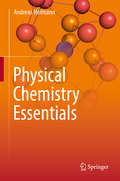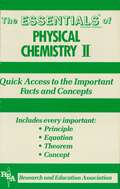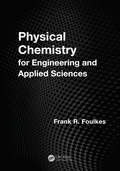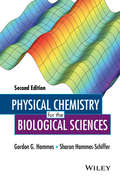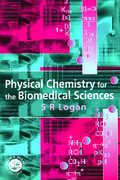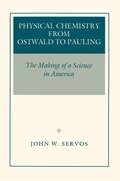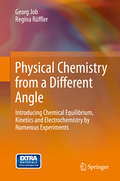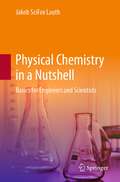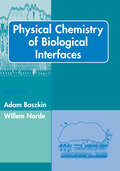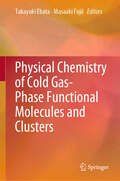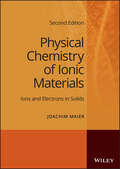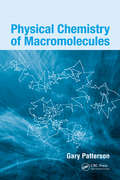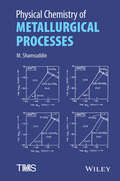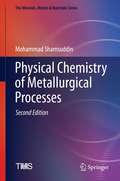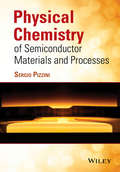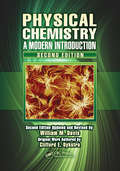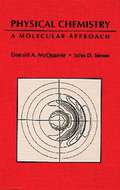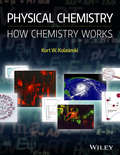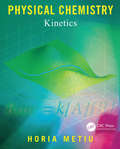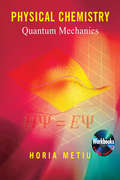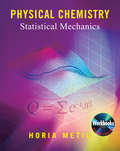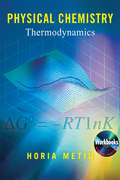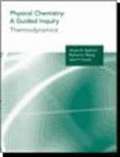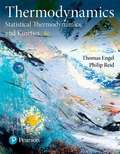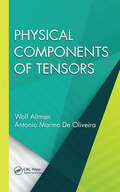- Table View
- List View
Physical Chemistry Essentials
by Andreas HofmannThis textbook covers the fundamentals of physical chemistry, explaining the concepts in an accessible way and guiding the readers in a step-by-step manner. The contents are broadly divided into two sections: the classical physico-chemical topics (thermodynamics, kinetics, electrochemistry, transport, and catalysis), and the fabric of matter and its interactions with radiation. Particular care has been taken in the presentation of the algebraic parts of physico-chemical concepts, so that the readers can easily follow the explanations and re-work relevant discussion and derivations with pen and paper. The book is accompanied by a rich mathematical appendix. Each chapter includes a selection of (numerical) exercises and problems, so that students can practice and apply the learned topics. An appendix with solutions allows for controlling the learning success. Carefully prepared illustrative color images make this book a great support for teaching physical chemistry to undergraduate students.This textbook mainly addresses undergraduate students in life sciences, biochemistry or engineering, offering them a comprehensive and comprehensible introduction for their studies of physical chemistry. It will also appeal to undergraduate chemistry students as an accessible introduction for their physical chemistry studies.
Physical Chemistry II Essentials
by The Editors of REAREA's Essentials provide quick and easy access to critical information in a variety of different fields, ranging from the most basic to the most advanced. As its name implies, these concise, comprehensive study guides summarize the essentials of the field covered. Essentials are helpful when preparing for exams, doing homework and will remain a lasting reference source for students, teachers, and professionals. Physical Chemistry II includes reaction mechanisms, theoretical approaches to chemical kinetics, gravitational work, electrical and magnetic work, surface work, kinetic theory, collisional and transport properties of gases, statistical mechanics, matter and waves, quantum mechanics, and rotations and vibrations of atoms and molecules.
Physical Chemistry for Engineering and Applied Sciences
by Frank R. FoulkesPhysical Chemistry for Engineering and Applied Sciences is the product of over 30 years of teaching first-year Physical Chemistry as part of the Faculty of Applied Science and Engineering at the University of Toronto. Designed to be as rigorous as compatible with a first-year student's ability to understand, the text presents detailed step-by-step
Physical Chemistry for the Biological Sciences
by Sharon Hammes-Schiffer Gordon G. HammesThis book provides an introduction to physical chemistry that is directed toward applications to the biological sciences. Advanced mathematics is not required. This book can be used for either a one semester or two semester course, and as a reference volume by students and faculty in the biological sciences.
Physical Chemistry for the Biomedical Sciences
by S.R. LoganThis is an introductory text for students which will bring them up to speed ready for first-year university level physical chemistry. The text begins by looking at atoms and their structure, and goes on to study different phases of matter and relates them to forces acting between molecules. As the book progresses, it analyses both phase and chemical equilibria, energy and kinetics, and the final section is about reactive free radicals.
Physical Chemistry from Ostwald to Pauling: The Making of a Science in America
by John W. ServosJohn Servos explains the emergence of physical chemistry in America by presenting a series of lively portraits of such pivotal figures as Wilhelm Ostwald, A. A. Noyes, G. N. Lewis, and Linus Pauling, and of key institutions, including MIT, the University of California at Berkeley, and Caltech. In the early twentieth century, physical chemistry was a new hybrid science, the molecular biology of its time. The names of its progenitors were familiar to everyone who was scientifically literate; studies of aqueous solutions and of chemical thermodynamics had transformed scientific knowledge of chemical affinity. By exploring the relationship of the discipline to industry and to other sciences, and by tracing the research of its leading American practitioners, Servos shows how physical chemistry was eclipsed by its own offspring--specialties like quantum chemistry.
Physical Chemistry from a Different Angle
by Georg Job Regina RüfflerLearning the basics of physical chemistry with a unique, innovative approach. Georg Job and Regina Rueffler introduce readers to an almost intuitive understanding of the two fundamental concepts, chemical potential and entropy. Avoiding complex mathematics, these concepts are illustrated with the help of numerous demonstration experiments. Using these concepts, the subjects of chemical equilibria, kinetics and electrochemistry are presented at an undergraduate level. The basic quantities and equations necessary for the qualitative and quantitative description of chemical transformations are introduced by using everyday experiences and particularly more than one hundred illustrative experiments, many presented online as videos. These are in turn supplemented by nearly 400 figures, and by learning objectives for each chapter. From a review of the German edition: "This book is the most revolutionary textbook on physical chemistry that has been published in the last few decades. "
Physical Chemistry in a Nutshell: Basics for Engineers and Scientists
by Jakob SciFox LauthThis book is based on a multimedia course for biological and chemical engineers, which is designed to trigger students' curiosity and initiative. A solid basic knowledge of thermodynamics and kinetics is necessary for understanding many technical, chemical, and biological processes.The one-semester basic lecture course was divided into 12 workshops (chapters). Each chapter covers a practically relevant area of physical chemistry and contains the following didactic elements that make this book particularly exciting and understandable:- Links to Videos at the start of each chapter as preparation for the workshop - Key terms (in bold) for further research of your own- Comprehension questions and calculation exercises with solutions as learning checks - Key illustrations as simple, easy-to-replicate blackboard picturesHumorous cartoons for each workshop (by Faelis) additionally lighten up the text and facilitate the learning process as a mnemonic. To round out the book, the appendix includes a summary of the most popular experiments in basic physical chemistry courses, as well as suggestions for designing workshops with exhibits, experiments, and "questions of the day."Suitable for students minoring in chemistry; chemistry majors are sure to find this slimmed-down, didactically valuable book helpful as well. The book is excellent for self-study.
Physical Chemistry of Biological Interfaces
by Willem Norde Adam BaszkinAn introduction to the most important fundamental concepts of physicochemical interface science and a description of experimental techniques and applications of surface science in relation to biological systems. It explores artificial assemblies of lipids, proteins and polysaccharides that perform novel functions that living systems cannot duplicat
Physical Chemistry of Cold Gas-Phase Functional Molecules and Clusters
by Takayuki Ebata Masaaki FujiiThis book describes advanced research on the structures and photochemical properties of polyatomic molecules and molecular clusters having various functionalities under cold gas-phase conditions. Target molecules are crown ethers, polypeptides, large size protonated clusters, metal clusters, and other complex polyatomic molecules of special interest. A variety of advanced frequency and time-domain laser spectroscopic methods are applied. The book begins with the principle of an experimental setup for cold gas-phase molecules and various laser spectroscopic methods, followed by chapters on investigation of specific molecular systems. Through a molecular-level approach and analysis by quantum chemical calculation, it is possible to learn how atomic and molecular-level interactions (van der Waals, hydrogen-bonding, and others) control the specific properties of molecules and clusters. Those properties include molecular recognition, induced fitting, chirality, proton and hydrogen transfer, isomerization, and catalytic reaction. The information will be applicable to the design of new types of functional molecules and nanoparticles in the broad area that includes applied chemistry, drug delivery systems, and catalysts.
Physical Chemistry of Ionic Materials: Ions and Electrons in Solids
by Joachim MaierDiscover the physical chemistry of charge carriers in the second edition of this popular textbook Ionic and electronic charge carriers are critical to the kinetic and electrochemical properties of ionic solids. These charge carriers are point defects and are decisive for electrical conductivity, mass transport, and storage phenomena. Generally, defects are deviations from the perfect structure, and if higher-dimensional, also crucial for the mechanical properties. The study of materials science and energy research therefore requires a thorough understanding of defects, in particular the charged point defects, their mobilities, and formation mechanisms. Physical Chemistry of Ionic Materials is a comprehensive introduction to these charge carrier particles and the processes that produce, move, and activate them. Covering both core principles and practical applications, it discusses subjects ranging from chemical bonding and thermodynamics to solid-state kinetics and electrochemical techniques. Now in an updated edition with numerous added features, it promises to be the essential textbook on this subject for a new generation of materials scientists. Readers of the 2nd Edition of Physical Chemistry of Ionic Materials will also find: Two new chapters on solid state electrochemistry and another on nanoionics Novel brief sections on photoelectrochemistry, bioelectrochemistry, and atomistic modelling put the treatment into a broader context Discussion of the working principles required to understand electrochemical devices like sensors, batteries, and fuel cells Real laboratory measurements to ground basic principles in practical experimentation Physical Chemistry of Ionic Materials is a valuable reference for chemists, physicists, and any working researchers or advanced students in the materials sciences.
Physical Chemistry of Macromolecules
by Gary PattersonWritten by a chemical physicist specializing in macromolecular physics, this book brings to life the definitive work of celebrated scientists who combined multidisciplinary perspectives to pioneer the field of polymer science. The author relates firsthand the unique environment that fostered the experimental breakthroughs underlying some of today's
Physical Chemistry of Metallurgical Processes
by M. ShamsuddinThis book covers various metallurgical topics, viz. roasting of sulfide minerals, matte smelting, slag, reduction of oxides and reduction smelting, interfacial phenomena, steelmaking, secondary steelmaking, role of halides in extraction of metals, refining, hydrometallurgy and electrometallurgy. Each chapter is illustrated with appropriate examples of applications of the technique in extraction of some common, reactive, rare or refractory metal together with worked out problems explaining the principle of the operation.
Physical Chemistry of Metallurgical Processes, Second Edition (The Minerals, Metals & Materials Series)
by Mohammad ShamsuddinThis updated, second edition retains its classroom-tested treatment of physical chemistry of metallurgical topics, such as roasting of sulfide minerals, matte smelting, converting, structure, properties and theories of slag, reduction of oxides and reduction smelting, interfacial phenomena, steelmaking, secondary steelmaking, role of halides in extraction of metals, refining, hydrometallurgy and electrometallurgy, and adds new data in worked-out examples as well as up-to-date references to the literature. The book further explains the physical chemistry of various metallurgical topics, steps involved in extraction of metals, such as roasting, matte smelting/converting, reduction smelting, steelmaking reactions, deoxidation, stainless steelmaking, vacuum degassing, refining, leaching, chemical precipitation, ion exchange, solvent extraction, cementation, gaseous reduction and electrowinning. Each topic is illustrated with appropriate examples of applications of the technique in extraction of some common, reactive, rare, or refractory metal together with worked out problems explaining the principle of the operation. The problems require imagination and critical analyses and also encourage readers for creative application of thermodynamic data in metal extraction.Updates and condenses text throughout the book by sequential arrangement of paragraphs in different chapters;Maximizes readers’ understanding of the physicochemical principles involved in extraction/production of common and rare/reactive metals by pyro- as well as hydrometallurgical routes;Reinforces concepts presented with worked examples in each chapter explaining the process steps;Explains the physical chemistry of various metallurgical steps, such as roasting, matte smelting/converting, and reduction smelting, steelmaking, aqueous processing etc. in extraction of metals;Collects and uniformly presents scattered information on physicochemical principles of metal production from various books and journals.
Physical Chemistry of Semiconductor Materials and Processes
by Sergio PizziniThe development of semiconductor devices began a little more than a century ago, with the discovery of the electrical conductivity of ionic solids. Today, solid state technologies form the background of the society in which we live. The aim of this book is threefold: to present the background physical chemistry on which the technology of solid state devices is based; secondly, to describe specific issues such as the role of defects on the properties of solids, and the crucial influence of surface properties; and ultimately, to look at the physics and chemistry of growth processes, both at the bulk and thin-film level, together with some issues relating to the properties of nano-devices. Divided into five chapters, it covers: Thermodynamics of solids, including phases and their properties and structural order Point defects in semiconductors Extended defects in semiconductors and their interactions with point defects and impurities Growth of semiconductor materials Physical chemistry of semiconductor materials processing With applications across all solid state technologies,the book is useful for advanced students and researchers in materials science, physics, chemistry, electrical and electronic engineering. It is also useful for those in the semiconductor industry.
Physical Chemistry: A Modern Introduction, Second Edition
by William M. DavisDesigned specifically for a two-semester introductory course sequence in physical chemistry, this text presents core principles and topics. Straightforward and streamlined, it presents the necessary amount of detail for comprehension. Organized in such a way that the various topics covered are connected to each other, it allows students to see physical chemistry as an interconnected discipline and not a series of unrelated concepts. Each chapter in this new edition has been thoroughly updated and includes new information on computational applications, more end-of-chapter problems, and new chapters on nanotechnology and surface chemistry
Physical Chemistry: A Molecular Approach
by Donald A. Mcquarrie John D. SimonThis book provides a contemporary approach to the study of physical chemistry. By beginning with quantum chemistry, students will learn the fundamental principles upon which all modern physical chemistry is built.
Physical Chemistry: How Chemistry Works
by Kurt W. KolasinskiMuch of chemistry is motivated by asking 'How'? How do I make a primary alcohol? React a Grignard reagent with formaldehyde. Physical chemistry is motivated by asking 'Why'? The Grignard reagent and formaldehyde follow a molecular dance known as a reaction mechanism in which stronger bonds are made at the expense of weaker bonds. If you are interested in asking 'why' and not just 'how', then you need to understand physical chemistry. Physical Chemistry: How Chemistry Works takes a fresh approach to teaching in physical chemistry. This modern textbook is designed to excite and engage undergraduate chemistry students and prepare them for how they will employ physical chemistry in real life. The student-friendly approach and practical, contemporary examples facilitate an understanding of the physical chemical aspects of any system, allowing students of inorganic chemistry, organic chemistry, analytical chemistry and biochemistry to be fluent in the essentials of physical chemistry in order to understand synthesis, intermolecular interactions and materials properties. For students who are deeply interested in the subject of physical chemistry, the textbook facilitates further study by connecting them to the frontiers of research. * Provides students with the physical and mathematical machinery to understand the physical chemical aspects of any system.* Integrates regular examples drawn from the literature, from contemporary issues and research, to engage students with relevant and illustrative details.* Important topics are introduced and returned to in later chapters: key concepts are reinforced and discussed in more depth as students acquire more tools. * Chapters begin with a preview of important concepts and conclude with a summary of important equations.* Each chapter includes worked examples and exercises: discussion questions, simple equation manipulation questions, and problem-solving exercises. * Accompanied by supplementary online material: worked examples for students and a solutions manual for instructors.* Written by an experienced instructor, researcher and author in physical chemistry, with a voice and perspective that is pedagogical and engaging.
Physical Chemistry: Kinetics
by Horia MetiuThis is a new undergraduate textbook on physical chemistry by Horia Metiu published as four separate paperback volumes. These four volumes on physical chemistry combine a clear and thorough presentation of the theoretical and mathematical aspects of the subject with examples and applications drawn from current industrial and academic research. By using the computer to solve problems that include actual experimental data, the author is able to cover the subject matter at a practical level. The books closely integrate the theoretical chemistry being taught with industrial and laboratory practice. This approach enables the student to compare theoretical projections with experimental results, thereby providing a realistic grounding for future practicing chemists and engineers. Each volume of Physical Chemistry includes Mathematica® and Mathcad® Workbooks on downloadable resources.Metiu's four separate volumes-Thermodynamics, Statistical Mechanics, Kinetics, and Quantum Mechanics-offer built-in flexibility by allowing the subject to be covered in any order.These textbooks can be used to teach physical chemistry without a computer, but the experience is enriched substantially for those students who do learn how to read and write Mathematica® or Mathcad® programs. A TI-89 scientific calculator can be used to solve most of the exercises and problems.® Mathematica is a registered trademark of Wolfram Research, Inc.® Mathcad is a registered trademark of Mathsoft Engineering & Education, Inc.
Physical Chemistry: Quantum Mechanics
by Horia MetiuThis is a new undergraduate textbook on physical chemistry by Horia Metiu published as four separate paperback volumes. These four volumes on physical chemistry combine a clear and thorough presentation of the theoretical and mathematical aspects of the subject with examples and applications drawn from current industrial and academic research. By using the computer to solve problems that include actual experimental data, the author is able to cover the subject matter at a practical level. The books closely integrate the theoretical chemistry being taught with industrial and laboratory practice. This approach enables the student to compare theoretical projections with experimental results, thereby providing a realistic grounding for future practicing chemists and engineers. Each volume of Physical Chemistry includes Mathematica® and Mathcad® Workbooks on downloadable resources.Metiu's four separate volumes-Thermodynamics, Statistical Mechanics, Kinetics, and Quantum Mechanics-offer built-in flexibility by allowing the subject to be covered in any order.These textbooks can be used to teach physical chemistry without a computer, but the experience is enriched substantially for those students who do learn how to read and write Mathematica® or Mathcad® programs. A TI-89 scientific calculator can be used to solve most of the exercises and problems.® Mathematica is a registered trademark of Wolfram Research, Inc.® Mathcad is a registered trademark of Mathsoft Engineering & Education, Inc.
Physical Chemistry: Statistical Mechanics
by Horia MetiuThis is a new undergraduate textbook on physical chemistry by Horia Metiu published as four separate paperback volumes. These four volumes on physical chemistry combine a clear and thorough presentation of the theoretical and mathematical aspects of the subject with examples and applications drawn from current industrial and academic research. By using the computer to solve problems that include actual experimental data, the author is able to cover the subject matter at a practical level. The books closely integrate the theoretical chemistry being taught with industrial and laboratory practice. This approach enables the student to compare theoretical projections with experimental results, thereby providing a realistic grounding for future practicing chemists and engineers. Each volume of Physical Chemistry includes Mathematica® and Mathcad® Workbooks on downloadable resources.Metiu's four separate volumes-Thermodynamics, Statistical Mechanics, Kinetics, and Quantum Mechanics-offer built-in flexibility by allowing the subject to be covered in any order.These textbooks can be used to teach physical chemistry without a computer, but the experience is enriched substantially for those students who do learn how to read and write Mathematica® or Mathcad® programs. A TI-89 scientific calculator can be used to solve most of the exercises and problems.® Mathematica is a registered trademark of Wolfram Research, Inc.® Mathcad is a registered trademark of Mathsoft Engineering Education, Inc.
Physical Chemistry: Thermodynamics
by Horia MetiuThis is a new undergraduate textbook on physical chemistry by Horia Metiu published as four separate paperback volumes. These four volumes on physical chemistry combine a clear and thorough presentation of the theoretical and mathematical aspects of the subject with examples and applications drawn from current industrial and academic research. By using the computer to solve problems that include actual experimental data, the author is able to cover the subject matter at a practical level. The books closely integrate the theoretical chemistry being taught with industrial and laboratory practice. This approach enables the student to compare theoretical projections with experimental results, thereby providing a realistic grounding for future practicing chemists and engineers. Each volume of Physical Chemistry includes Mathematica® and Mathcad® Workbooks on downloadable resources.Metiu's four separate volumes-Thermodynamics, Statistical Mechanics, Kinetics, and Quantum Mechanics-offer built-in flexibility by allowing the subject to be covered in any order.These textbooks can be used to teach physical chemistry without a computer, but the experience is enriched substantially for those students who do learn how to read and write Mathematica® or Mathcad® programs. A TI-89 scientific calculator can be used to solve most of the exercises and problems.® Mathematica is a registered trademark of Wolfram Research, Inc.® Mathcad is a registered trademark of Mathsoft Engineering & Education, Inc.
Physical Chemistry: Thermodynamics
by James N. Spencer Richard S. Moog John J. FarrellDesigned to encourage active and collaborative learning in the physical chemistry classroom, this text is a collection of group activities (ChemActivities) that can accompany any physical chemistry text.
Physical Chemistry: Thermodynamics, Statistical Thermodynamics, and Kinetics
by Thomas Engel Philip ReidEngel and Reid’s Thermodynamics, Statistical Thermodynamics, and Kinetics provides a contemporary, conceptual, and visual introduction to physical chemistry. The authors emphasize the vibrancy of physical chemistry today and illustrate its relevance to the world around us, using modern applications drawn from biology, environmental science, and material science. The 4th Edition provides visual summaries of important concepts and connections in each chapter, offers students “just-in-time” math help, and expands content to cover science relevant to physical chemistry. Tutorials in Mastering™ Chemistry reinforce students’ understanding of complex theory in Quantum Chemistry and Thermodynamics as they build problem-solving skills throughout the course.
Physical Components of Tensors (Applied and Computational Mechanics)
by Wolf Altman Antonio Marmo OliveiraIllustrating the important aspects of tensor calculus, and highlighting its most practical features, Physical Components of Tensors presents an authoritative and complete explanation of tensor calculus that is based on transformations of bases of vector spaces rather than on transformations of coordinates. Written with graduate students, professors, and researchers in the areas of elasticity and shell theories in mind, this text focuses on the physical and nonholonomic components of tensors and applies them to the theories. It establishes a theory of physical and anholonomic components of tensors and applies the theory of dimensional analysis to tensors and (anholonomic) connections. This theory shows the relationship and compatibility among several existing definitions of physical components of tensors when referred to nonorthogonal coordinates. The book assumes a basic knowledge of linear algebra and elementary calculus, but revisits these subjects and introduces the mathematical backgrounds for the theory in the first three chapters. In addition, all field equations are also given in physical components as well.Comprised of five chapters, this noteworthy text: Deals with the basic concepts of linear algebra, introducing the vector spaces and the further structures imposed on them by the notions of inner products, norms, and metrics Focuses on the main algebraic operations for vectors and tensors and also on the notions of duality, tensor products, and component representation of tensors Presents the classical tensor calculus that functions as the advanced prerequisite for the development of subsequent chapters Provides the theory of physical and anholonomic components of tensors by associating them to the spaces of linear transformations and of tensor products and advances two applications of this theory Physical Components of Tensors contains a comprehensive account of tensor calculus, and is an essential reference for graduate students or engineers concerned with solid and structural mechanics.
